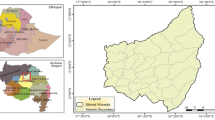Decline of soil microarthropod biodiversity is described in the sequence: old forest stands, low-input grasslands, high-input grasslands (with and without the use of persistent pesticides). With this expected trend of declining biodiversity, the patterns of species losses are analysed with the use of classifications of life-history tactics, feeding guilds and tolerances to drought. Species intolerant to drought are absent in grasslands, but present in old forest stands. Also the fraction of thelytokously reproducing microarthropods is higher in old forest stands compared with low-input grasslands. The main difference between low-input and high-input grasslands is found in the feeding guild structure of the community. Low-input grasslands are dominated by (herbo-) fungivorous grazers, whereas high-input grasslands are dominated by fungivorous browsers. Application of DDT in high-input grasslands shows a high density of microarthropods with a high fraction of thelytokous reproduction, associated with a decrease in genetic variation in a thelytokously reproducing species. Patterns in species losses, the species filters, are explained and discussed. It is shown that the decline of biodiversity is not a randorn loss of species but follows and identifiable pattern.
Similar content being viewed by others
References
Anderson, J.M. (1975) The enigma of soil animal species diversity. In: Progress in Soil Zoology (J. Vanek, ed.) pp. 51–8. The Hague: Junk BV.
Bengtsson, J. (1994) Temporal predictability in forest soil communities. J. Anim. Ecol. 63, 653–65.
Crossley, D.A. Jr, Mueller, B.R. and Perdue, J.C. (1992) Biodiversity of microarthropods in agricultural soils: relations to processes. Agricult. Ecosyst. Env. 40, 37–46.
Grandjean, F. (1941) Statistique sexuelle et parthénogenese chez les Oribates (Acariens). Compte rendu hebdomadaire Séance Académie Scientifique Paris 212, 463–7.
Hengeveld, R. (1994) Biodiversity-the diversification of life in a non-equilibrium world. Biodiver. Let. 2, 1–10.
Houte de Lange, S.M. ten (1977) Rapport van het Veluwe-onderzoek: een onderzoek van natuur, landschap en cultuurhistorie ten behoeve van de ruimtelijke ordening en het recreatiebeleid. Wageningen: Pudoc.
Karg, W. (1971) Acari (Acarina), Milben Unterordnung Anactinochaeta (Parasitiformes), Die freilebenden Gamasina (Gamasides), Raubmilben. Die Tierwelt Deutschlands 59, Jena: Gustav Fischer Verlag.
Karppinen, E. (1958) Über die Oribatiden (Acar.) der finnischen Waldböden. Ann. Zool. Soc. Vanamo 19, 1–43.
Krczal, H. (1959) Systematiek und Ökologie der Pyemotiden. Beiträge zur Systematik und Ökologie mitteleuropaischer Acarina 1, Abschnitt 3, 385–625.
Lindquist, E.E. (1986) The world genera of Tarsonemidae (Acari: Heterostigmata): a morphological, phylogenetic, and systematic revision, with a reclassification of family-group taxa in the Heterostigmata. Mem. Entomol. Soc. Canada 136, 1–517.
Martijn, A., Bakker, H. and Schreuder, R.H. (1993) Soil persistence of DDT, Dieldrin, and Lindane over a long period. Bull. Environm. Cont. Toxicol. 51, 178–84.
Moritz, M. (1965) Untersuchungen über den Einfluß von Kahlschlagmaßnahmen auf die Zusammensetzung von Hornmilbengemeinschaften (Acari: Oribatei) norddeutscher Laubund Kiefernmischwälder. Pedobiologia 5, 65–101.
Petersen, H. (1971) Parthenogenesis in two species of Collembola: Tullbergia krausbaueri (Boerner) and Isotoma notabilis (Schaeffer). Rev. d'Écol. Biol. Sol 8, 133–8.
Siepel, H. (1992) Recovering of natural processes in abandoned agricultural areas: decomposition of organic matter. In: Proceedings of the 4th European Congress of Entomology (L. Zombori and L. Peregovits, eds) pp. 374–9. Budapest.
Siepel, H. (1994) Life-history tactics of soil microarthropods. Biol. Fertil. Soils 18, 263–78.
Siepel, H. (1995) Applications of microarthropod life-history tactics in nature management and ecotoxicology. Biol. Fertil. Soils 19, 75–83.
Siepel, H. and van de Bund, C.F. (1988) The influence of management practices on the microarthropod community of grassland. Pedobiologia 31, 339–54.
Siepel, H. and Maaskamp, F. (1994) Mites of different feeding guilds affect decomposition of organic matter. Soil Biol. Biochem. 26, 1389–94.
Siepel, H. and de Ruiter-Dijkman, E.M. (1993) Feeding guilds of oribatid mites based on carbohydrase enzyme activities. Soil Biol. Biochem. 25, 1491–7.
Soil Survey Staff (1975) Soil Taxonomy. A basic system of soil classification for making and interpreting soil surveys. Agriculture Handbook 436. Washington: Soil Conservation Service. US Department of Agriculture.
Taberly, G. (1987) Rechèrches sur la parthénogenese thélytoque de deux èspeces d'acariens oribates: Trhypochthonius tectorum (Berlese) et Platynothrus peltifer (Koch). I. Acarologia 28. 187–98.
Tischler, E. (1965) Agrarökologie. Jena: Gustav Fischer Verlag.
Walter, D.E., Hunt, H.W. and Elliott, E.T. (1988) Guilds or functional groups? An analysis ot predatory arthropods from a shortgrass steppe soil. Pedobiologia 31, 247–60.
Woodring, J.P. and Cook, E.F. (1962) The biology of Ceratozetes cisalpinus Berlese, Scheloribates laevigatus Koch, and Oppia neerlandica Oudemans (Oribatei), with a description of all stages. Acarologia 4, 101–36.
Author information
Authors and Affiliations
Rights and permissions
About this article
Cite this article
Siepel, H. Biodiversity of soil microarthropods: the filtering of species. Biodivers Conserv 5, 251–260 (1996). https://doi.org/10.1007/BF00055834
Received:
Revised:
Accepted:
Issue Date:
DOI: https://doi.org/10.1007/BF00055834




